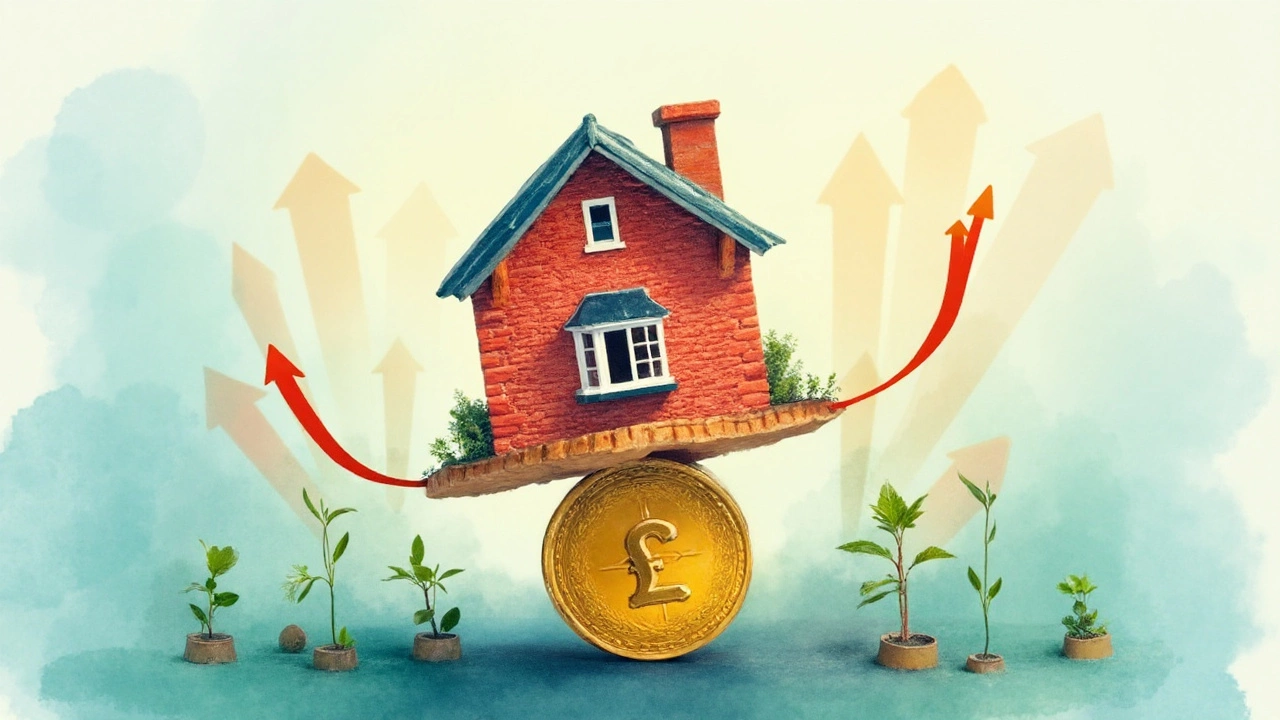Picture this: rents hit record highs in half the country, yet some landlords say they barely break even. Where’s the money going? And how do you actually know if your rental is paying its way? Digging through headlines and real-life stories, it’s clear—most folks have no clue what counts as a healthy profit on a rental property in 2025. Miss the mark, and that supposed nest egg can quietly drain your cash for years. Get it right, and you can build real wealth on the side—sometimes without even leaving your day job.
What is a Good Profit Margin for Rental Properties?
If you ask ten landlords about a “good” rental property profit margin, you’ll hear ten different numbers. But real estate pros usually point to two ways to track profits: cash flow and rental yield. Cash flow is easy—just subtract all your expenses from rent each month. If you’re not making anything after paying your mortgage, insurance, taxes, and repairs, something isn’t adding up. Rental yield is the annual rent divided by the purchase price, usually shown as a percentage.
Today, experts throw around 6-8% as a solid gross rental yield in most cities. That means if you buy a place for £200,000 (or $250,000), you’d expect £12,000 to £16,000 in annual rent before expenses. Actual profits—once you pay everything—might shrink to 3-5%. Here’s a fact: According to Savills’ 2025 Buy-to-Let Report, the average net yield for UK landlords is just 4.2%, while in the US, ATTOM’s Q2 2025 figures show a typical net yield of 6.1% across major metropolitan areas. Big cities, especially trendy ones, often show lower yields but steadier long-term value. Cheaper towns may offer eye-popping yields but can mean more hassle and risk.
But don’t forget inflation. A 5% profit can feel much skinnier if prices jump 6% a year. Consider this: If you clear $600 a month in real profit on a $250,000 place, that’s $7,200 a year—or a 2.88% net yield. Not exactly “greedy landlord” territory! Yet many owners settle for even less, especially if they’re betting on property values rising, not steady cash in hand.
| Country | Average Gross Yield (2025) | Average Net Yield | Typical Rent (Monthly) |
|---|---|---|---|
| UK | 5.2% | 4.2% | £1,200 |
| USA | 7.8% | 6.1% | $2,100 |
| Australia | 6.3% | 5.4% | AU$2,400 |
| Canada | 4.8% | 3.7% | CA$2,800 |
Chasing high returns without doing the math can hurt. The “profit” number is only real if you set cash aside for future repairs, vacancies, and bad tenants. Not every landlord does. Just because your rental isn’t draining your bank account doesn’t mean it’s actually profitable.
Breaking Down Real Costs: What Eats Up Your Rental Profit?
Rent comes in—and then it goes out. Anyone who’s owned a rental for a few years will tell you: it’s not as simple as mortgage plus rent equals easy money. Here’s where returns evaporate: property taxes, insurance, repairs, capital expenditures (think new roofs and boilers), legal fees, vacancy periods, and management costs if you hire help. Every region and property throws up its own curveballs. In California, landlords have seen insurance premiums triple. In inner London, ground rents, and service charges devour profits in apartment blocks.
Even so-called “hands-off” investments like managed apartments or new builds hide costs. Most people forget to budget for wear-and-tear, so the real profit shrinks with every leaky sink and broken fridge. Savvy landlords build in a 10%-15% reserve for maintenance. If you’re running at break-even and something explodes, kiss your annual profit goodbye. Here’s a raw truth: The National Association of Residential Property Managers in the US recomends setting aside at least one month’s rent per year for repairs—and more for older homes.
Vacancies will hit, too. Few rentals stay occupied 12 months a year, year after year. Even in strong markets, one bad tenant or a slow spell can empty your place for weeks. That’s money off the top. In fact, the Real Estate Institute of Australia’s 2025 data pegs average vacancy rates at 3.1% nationally—but it jumps to 6% in remote areas. Factor in cleaning, marketing, letting agent fees, and you quickly see why some landlords miss their profit targets. Doing the math up front changes everything.

Calculating Profit: Crunching the Numbers Right
You’d think rental property accounting would be simple, but too many new investors focus only on rent minus mortgage. That’s not enough. The real calculation takes effort, but it stops you getting burned—especially when rates or taxes jump.
- Gross rental income: All rent you collect in a year.
- Minus:
- Mortgage interest (not the full payment if you’re just counting interest)
- Insurance
- Taxes (property and sometimes business tax for large portfolios)
- Maintenance and repairs (avg. of 10% of rent)
- Capital expenditures (boilers, roofs, appliances—annualized over expected lifespan)
- Vacancy loss (plan for at least 1 month/year vacant)
- Property management fees (8-12% of rent if you use an agent)
- = Net rental profit
Want an actual formula?
“Net Profit = (Annual Rental Income – All Expenses) / Property Value x 100”Simple? It’s not complicated, but most investors fudge the expenses or count on zero vacancies, which is a pipe dream. Getting the right numbers up front keeps you from surprises. Today’s world—with rising repair costs, higher mortgage rates (US averages bounced to 5.3% in 2025, UK standard rates hit 6.1% by July)—makes tight math even more necessary. Don’t let wishful thinking guide you; put the real numbers on paper first.
It’s smart to use spreadsheets or free online calculators (like the BiggerPockets Rental Calculator or Zoopla’s UK-specific calculators) to run a few what-if scenarios. What happens if rent drops, or if interest rates nudge up, or if you need to sink $10,000 into a new kitchen? The best landlords know their numbers like they know the backs of their hands.
What Impacts Your Profit: Market Trends and Location
Timing and place can make or break your profits. The wild ride of 2020-2025 rewrote what success looks like. Some cities, like Manchester or Austin, saw rents outpace inflation every year; others, like San Francisco and Sydney, actually dipped or stagnated. Rental demand still booms in university towns and commutable suburbs, but it’s softening in some city centers. New build-to-rent apartments have added competition—and kept a lid on rents in some neighbourhoods. Investors who bought in the right spot at the right time, near transit, major employers, or top schools, usually come out on top.
But don’t be fooled by pure numbers. High-yield, low-value areas can chew through your profits with bigger repairs, higher turnover, and tenants who pay late or leave chaos behind. Premium locations (even with lower yields) tend to offer longer-term tenants and fewer horror stories. The old wisdom holds true: buy the worst house on the best street, not the fanciest place in the cheapest neighborhood.
Today, short-term lets through Airbnb and Vrbo tempt landlords with huge nightly rates, but city rules have tightened. Berlin, Barcelona, and New York all restrict short-term rentals now, hitting profits for careless investors. If you’re banking on that model, check local laws before investing.
| City | 2025 Avg. Rent Growth | Vacancy Rate | Short-Term Rental Regulation |
|---|---|---|---|
| Manchester (UK) | +8.2% | 2.5% | Moderate (90 days/year cap) |
| Austin (US) | +6.7% | 4.2% | Strict (zoning required) |
| Barcelona (Spain) | +1.4% | 6.0% | Very Strict (permits limited) |
| Sydney (AUS) | -0.6% | 5.1% | Strict (180 days/year cap) |
“Location matters more than ever,” says Fiona Campbell, CEO of the UK Short Term Accommodation Association. “Profit isn’t just about headline rent, but who your tenants are and how long they stay.”

Ways to Boost Your Rental Property Profit
If your returns look thin, you’re not stuck with it. There are practical ways to nudge up your profits without gutting your property or taking wild risks. Quick wins: Shop for better insurance rates each year. Challenge your property tax assessment if local prices dropped—they’re often out of date. Even small changes add up.
- Switch to self-management if you have time. Property managers are great, but 8-12% a year can eat your bottom line fast.
- Improve energy efficiency: cheap insulation, LED lighting, and better heating systems can slash costs—and attract tenants willing to pay a premium for lower bills.
- Regular smaller upgrades (fresh paint, smart home gadgets, good Wi-Fi) can add 5-10% to your yearly rent in some cities.
- Screen tenants carefully—bad renters kill profit. Always run background and credit checks, and call references, even if it takes longer to fill the place.
- If local rental regulations allow, consider renting by the room to students or professionals, rather than single lets. The yield can jump 20-35% in areas near colleges or hospitals.
- Refinance your mortgage if rates drop, or switch to interest-only to boost short-term cash flow—just don’t ignore the risk of rising balances.
But the best tip? Keep your records sharp, review your numbers every quarter, and plan for the worst tenant, not the best. Every property has surprises—like that boiler, tenants leaving early, or sudden changes in local laws. Planning for that means the profit you make is actually yours to keep. Landlords who treat their rentals like a real business—with budgets, reserves, and steady upgrades—don’t just survive, they thrive.
